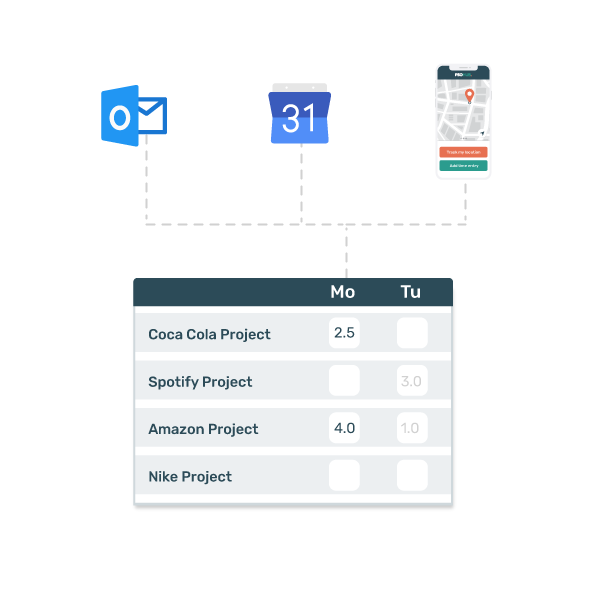Share this
Self-Driving Time Tracking: Go Straight from Google or Outlook to Invoicing
by Martijn van der Hoeden on April 2, 2020

You probably have already heard the term ‘self-driving’ thrown around a lot, especially in tech spheres or really anything to do with AI.
What exactly does self-driving mean? And what does it mean for your business’ productivity?
Most commonly, we hear self-driving and think of autonomous vehicles. Google is the name everybody associates with these, and their self-driving car project is now called Waymo.
Self-driving technology, however, is a broader term for systems that are able to operate on their own (automated). These systems are typically given a set parameters or rules to learn from and follow.
Similar to AI and AR/VR, self-driving technology is able to seamlessly interact with real world environments and situations.
When it comes to productivity, self-driving capabilities can empower individual users and entire organizations to focus more on the things that matter.
Like growing and scaling your business.
We list our tips for using technology for better time tracking. For businesses, this means getting from deal to cash faster.
If you want to find out more about the benefits of self-driving time tracking and if this is a solution that could possibly save your organization a lot of time and money, read on.
Who is self-driving time tracking for?
Professionals in service-based organizations are most familiar with time tracking. After all, it is the only way to monitor billable work and ensure proper billing and invoicing to clients. Professional Service Organizations (PSOs) are most likely to benefit from smart time-tracking solutions and include:
- Marketing Agencies
- IT Service & Consulting Companies
- Digital advertising and SEO firms
- Lawyers
- Accountants
- Architects
- Financial advisors
- Management Consultants
- And more.
Time tracking — especially when done manually —is not only time consuming but can also lead to inaccurate data. And bad data is no fun, neither for you nor your clients.
Benefits of Self-Driving Time Tracking
Self-driving time tracking is foremost a solution to eliminate errors, but when implemented properly, can benefit your business in a variety of ways:
- Reduce errors of manual time entry, such as missed hours, duplicate entries, or billing the wrong client.
- Reduce time spent focused on time tracking (you’d be surprised how much time employees and businesses waste doing this) and put that time toward activities that matter like driving leads, maximizing conversions, etc.
- Automate your billing by importing timesheets directly into invoices. This might be the best benefit of all — get paid faster!
Keep Reading: 3 Ways to Track Time and Bill More Accurately with HubSpot
Use your Google/Outlook calendar to track time
How can you start leveraging self-driving time tracking right now? Easy!
"The most ideal way for professionals to begin tracking time smarter is to start with their Google or Outlook calendar — this is where client meetings, site visits, team check-ins are already being logged."
For those who work remotely or developers who aren’t attending daily meetings (their work is usually happening offline), Outlook calendar time tracking or using your Google calendar time (in G Suite) will still require organization for creating time blocks before starting project tasks.
But there are ways to make time tracking even easier...
Plugins, integrations, extensions...oh my!
There are plenty of tools that work with Google or Outlook to track time based on calendar events, like Harvest and ClickUp, all of which offer simple setups. These tools are great options for those looking for an easy and quick solution to tracking time and analyzing timesheets. 
But some of these options still require manually assigning time logs to client projects and invoices.
The real magic of self-driving time tracking starts when these tools are able to automatically log time into client invoices. And even better, when these tools are able to recognize (remember) certain calendar events and help you log time more accurately in the future.
For example, feel free to continue using your Google or Outlook calendar for personal items or blocking out internal lunches — self-driving time tracking tools will understand that these time entries don’t belong to a client or project.
Ready for more magic? Time logs from smart, self-driving tools can automatically add entries to invoices that help you manage budgets better, keep track of project milestones, and send invoices when ready.
Learn more: Time & Expense Tracking with PSOhub
Self-driving time tracking for small business with PSOhub
We’re embracing innovative technology like self-driving time tracking to help teams increase their productivity and profitability. Feel free to contact us to find out more about how our platform powers self-driving time tracking as well as a bunch of other smart features that support automation and integrate directly with your CRM.
Share this
- Project Management (82)
- Productivity (61)
- Time Tracking (26)
- PSA Software (24)
- HubSpot (20)
- Resource Management (13)
- Invoicing (12)
- Salesforce (11)
- AI (7)
- Contract Management (7)
- Profitability (6)
- Gantt Chart (4)
- Microsoft Dynamics (4)
- Budget Management (3)
- Financial services (3)
- Integrations (3)
- Quickbooks (3)
- Quote (3)
- ROI (3)
- Traffic Management (3)
- collaboration (3)
- Consultancy (2)
- Digital Marketing & Advertising (2)
- Pipedrive (2)
- Work Management (2)
- About PSOhub (1)
- Automation (1)
- IT Companies (1)
- Risk Management (1)
- Ticket Sync (1)
- Workload Management (1)
- power bi (1)
- April 2025 (2)
- March 2025 (3)
- February 2025 (3)
- January 2025 (3)
- December 2024 (1)
- November 2024 (5)
- October 2024 (5)
- September 2024 (1)
- August 2024 (4)
- July 2024 (3)
- June 2024 (5)
- May 2024 (4)
- April 2024 (5)
- March 2024 (5)
- February 2024 (4)
- January 2024 (3)
- December 2023 (2)
- November 2023 (7)
- October 2023 (5)
- August 2023 (6)
- July 2023 (2)
- June 2023 (4)
- May 2023 (4)
- April 2023 (3)
- March 2023 (4)
- February 2023 (4)
- January 2023 (3)
- December 2022 (5)
- November 2022 (3)
- October 2022 (4)
- September 2022 (5)
- August 2022 (7)
- July 2022 (1)
- June 2022 (7)
- May 2022 (6)
- April 2022 (2)
- March 2022 (2)
- February 2022 (4)
- January 2022 (4)
- December 2021 (5)
- November 2021 (2)
- October 2021 (2)
- September 2021 (3)
- August 2021 (3)
- July 2021 (2)
- June 2021 (2)
- May 2021 (3)
- April 2021 (2)
- March 2021 (2)
- February 2021 (3)
- January 2021 (5)
- December 2020 (4)
- November 2020 (2)
- October 2020 (4)
- September 2020 (5)
- August 2020 (4)
- July 2020 (4)
- June 2020 (1)
- May 2020 (4)
- April 2020 (8)
- March 2020 (7)




